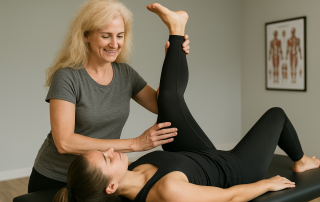The temporomandibular joint (TMJ) connects your jaw to your skull. It allows you to talk, chew, and yawn. But when this joint isn’t working well, it can cause pain and discomfort.
TMJ disorders are common. People may feel jaw pain, headaches, earaches, clicking sounds, or trouble opening and closing their mouth. These symptoms can affect daily life—but manual therapy offers safe and effective relief.
🧠 What Causes TMJ Disorders?
TMJ pain can come from several sources, including:
- Muscle tension or stress
- Poor posture (especially forward head posture)
- Teeth grinding or clenching
- Jaw injury
- Arthritis
- Misalignment of the jaw
The goal of manual therapy is to reduce muscle tightness, improve joint motion, and restore natural function.
💆♀️ How Manual Therapy Helps TMJ Pain
Manual therapy uses hands-on techniques to relieve tension and improve movement in the jaw, neck, and surrounding muscles. It can:
- Reduce jaw and facial pain
- Ease headaches and muscle tension
- Improve joint movement
- Decrease clicking or popping sounds
- Support better posture
Each treatment is tailored to the patient’s needs. A therapist will first assess how your jaw moves, how your muscles feel, and how your head and neck are aligned.

👐 Common Techniques Used
- Soft Tissue Release
The therapist uses their hands to gently massage and stretch the muscles around the jaw, cheeks, and neck. This helps reduce tightness and pain.
- Intraoral Techniques
With gloves on, the therapist may gently treat the muscles inside the mouth, such as the pterygoid muscles. These are often tight in people with TMJ pain.
- Joint Mobilization
Small, gentle movements are used to help the jaw joint move more freely and with less pain.
- Neck and Posture Work
Since posture affects the jaw, the therapist will often release tight neck muscles and correct forward head position to reduce strain on the TMJ.
🏋️♀️ Helpful Exercises You Can Do at Home
In addition to hands-on work, therapists often teach simple home exercises to stretch and strengthen the jaw.
- Jaw Relaxation: Let your tongue rest on the roof of your mouth and keep your jaw loose.
- Chin Tucks: Gently tuck your chin back to align your neck and support jaw function.
- Controlled Jaw Opening: Open your mouth slowly while keeping it aligned. Use a mirror if needed.
- Neck Stretching: Gentle side and front-of-neck stretches can relieve tension that affects the jaw.
- Postural correction: simply correcting your overall posture will change the stress on the jaw and shift pressure away from the joint.
These exercises help maintain results between sessions and prevent symptoms from returning.
📞 Find Relief with Manual Therapy
TMJ pain doesn’t have to control your life. At Manual Therapy Associates, we offer safe, hands-on treatments that help ease pain, improve jaw movement, and reduce stress on the joint.
If you’re dealing with jaw pain, clicking, or headaches, we’re here to help.
👉 Contact us today to book your personalized TMJ assessment and start feeling better—one step at a time.
Check out our Facebook!




